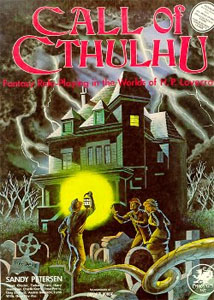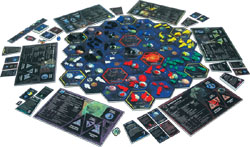The first really successful “post-crawl” scenario structure in the RPG industry is the mystery scenario. While it’s easy to find antecedents, it’s really with the publication of Call of Cthulhu in 1981 that the mystery scenario’s popularity exploded.
 Thirty years later it can be a little difficult to appreciate how radical Call of Cthulhu was and just how fresh a breath of air it provided. It’s been said that the game “busted gaming out of the dungeon” (which is more literally true if we understand “dungeon” to mean crawl-based scenario structures in general), but its revolution has now become ubiquitous. If you look at published scenarios today, mystery-based scenarios are at least as popular as crawl-based scenarios (and even the crawl-based scenarios often include a large dose of mystery-based play). And outside of D&D the victory is even more complete: Virtually every published scenario is mystery-based.
Thirty years later it can be a little difficult to appreciate how radical Call of Cthulhu was and just how fresh a breath of air it provided. It’s been said that the game “busted gaming out of the dungeon” (which is more literally true if we understand “dungeon” to mean crawl-based scenario structures in general), but its revolution has now become ubiquitous. If you look at published scenarios today, mystery-based scenarios are at least as popular as crawl-based scenarios (and even the crawl-based scenarios often include a large dose of mystery-based play). And outside of D&D the victory is even more complete: Virtually every published scenario is mystery-based.
The degree to which this marketplace dominance reflects actual practice at the gaming table can perhaps be quibbled with. But, either way, it’s actually rather curious once you start reflecting on it: Outside of gaming, mysteries are popular, but they aren’t all-consuming. (And even within gaming you don’t see mysteries consuming the board game or video game markets.)
There are probably several reasons for the popularity of mystery scenarios in RPGs. (For example, an unsolved mystery presents a challenge. Overcoming that challenge – by solving the mystery – provides the kind of clear-cut victory condition that can be achieved with only a few things outside of direct competition or combat.) But I suspect a large part of it is that mystery scenarios present straight-forward game structures that are (a) easy to explain to GMs and (b) intuitively grasped by players.
If we start to look at mystery scenarios using the same structural analysis we used for dungeoncrawls, it’s relatively easy to see this from the player’s point of view:
Default Goal? Solve the mystery.
Default Action? Look for clues.
At this point, however, we have to acknowledge that there’s something different about the mystery scenario structure. While it gives some guidance in answering the player’s question, “What do I do next?” it doesn’t provide a complete answer. Instead, once the players have found their clues, they’ll need to draw a conclusion from those clues. If they don’t draw the necessary conclusion, the mystery scenario will stop providing a default action for them to take.
In other words, mystery scenario structures are more fragile than dungeoncrawls. And this fragility becomes more evident as we shift to the GM’s side of the equation:
Easy to Prep? Unlike a dungeoncrawl, it’s very easy for a neophyte GM to screw up the design of a mystery scenario: If they don’t include a necessary clue, for example, or expect the players to make an intuitive leap they’re not capable of making, the scenario structure will break.
Easy to Run? At a macro-level, mystery scenarios are usually still chunked into smaller, more manageable packets (e.g., each location where clues can be found). But, unlike a basic ‘crawl, these chunks are not as firmly “firewalled”. This generally requires the GM to have a greater understanding of the scenario’s totality and makes a mystery scenario a little more difficult for neophytes to run.
At a micro-level, however, mystery scenarios are generally pretty easy to run if you’re using a skill-based system. (Which, perhaps not coincidentally, were becoming ubiquitous right around the same time mystery scenarios were sky-rocketing to dominance.) This is because skill-based systems can generally be broken down into (a) resolving the success or failure of a physical action or (b) the acquisition of information. Clues, of course, are a type of information, so skill-based systems provide a self-evident method of resolution.
By way of contrast, running a mystery-based scenario in a system like OD&D – which lacks a mechanical basis for determining clue acquisition – can be a lot more challenging. Of course, this difficulty can be overcome if you simply introduce such a mechanic. A simple one would be something like, “If the players say they’re looking around, they automatically find any clues in the area.”
The GUMSHOE system uses a similar mechanic. It says, “If the players say they’re using the right skill, they automatically find any matching clues in the area.” As a game structure, of course, this leaves something to be desired (encouraging, as it does, players to treat their skills like a laundry list in every scene).
But I digress.
FRAGILE SCENARIOS
The point here is that mystery scenarios are a relatively fragile scenario structure: More likely to leave the players stymied; more likely to leave new GMs confused; more difficult for new GMs to design.
What we will discover is that this is often true: Many of the RPG scenario structures we use are remarkably fragile. Like delicate sugar crystals, they are often smashed to smithereens during the course of actual play, forcing GMs to stitch them back together on-the-fly. The robust simplicity offered by the geography of a crawl-based scenario structure – “pick a direction and go” – is difficult to replicate.
Obviously, once you’re aware of the fragility in your game structures, you can start thinking about ways to make them more robust. The Three Clue Rule is a simple example of this: It provides a straight-forward methodology which specifically buttresses the fragile breaking point of a basic mystery scenario.
For now, however, our attention must turn back to the robust demesnes of the ‘crawl structure. For that, we’ll need to journey overland to the wild realms of the hexcrawl…














